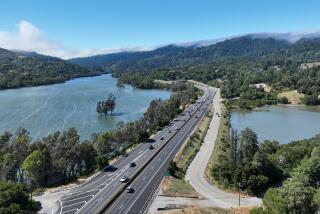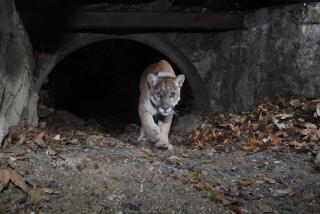The Devil Highway’s Number Is Finally Up
- Share via
TOHATCHI, N.M. — As long as he could remember, Edwin Begay felt there was something gravely troubling about U.S. 666, the road that runs by his hometown.
When Begay was a high school athlete, players from elsewhere on the Navajo reservation would razz him and his teammates for all the sinister cults they thought there must be beside a road named for the sign of the devil. Until recently, Begay tried to avoid saying 666 -- quite a feat, considering his house sits on the road’s west side and the school where he works sits on the east.
“I just tell people we’re north of Gallup,” he said. “We’ve gotten criticism over ‘the Satan road’ for years. It’s always been an offense to us.”
But no longer: Mindful of the biblical reference to “the number of the beast” that will usher in the end of the world, state officials in New Mexico, Colorado and Utah decided to beat the devil by changing his highway’s name.
After 77 years as U.S. 666, the road is to be called U.S. 491, by decree of the American Assn. of State Transportation and Highway Officials.
At a July 30 ceremony in the reservation town of Shiprock, the highway will be rededicated. Officials and residents will feast on mutton and fry bread. Navajo medicine men will issue traditional incantations.
“They’ll bless the new highway,” said S.U. Mahesh, a spokesman for New Mexico’s highway department. “And they’ll cleanse the old one.”
The road was named innocently enough in 1926. Highway officials only wanted to indicate it was the sixth spur off Route 66, the get-your-kicks highway later immortalized by Nat King Cole.
But good vibes have been elusive for the Navajos and Ute Mountain Utes who live near the pothole-riddled road. On the reservation, some see the number as a bad sign, malevolently placed upon the highway by a callous white establishment. Outside the reservation, residents shrug off such concerns as Native American superstition.
On a recent Sunday afternoon in a restaurant at the highway’s southern tip in Gallup, Jessica Lindberg, 18, bemoaned the demise of a geographic fixture she had known her entire life.
“It’s ridiculous!” said Lindberg, who works as a receptionist at a nursing home. “It’s historic! Everyone who lives in Gallup knows it as the triple-six.”
Long saddled with a reputation for drunk-driving collisions, the road rolls 193 miles north from Gallup to Monticello, Utah. In New Mexico, about 108 miles of it slice through the eastern edge of the sprawling Navajo reservation. Most of that stretch is two lanes, with barely a shoulder on either side.
In the distance, khaki cliffs loom. Spectacular rock formations rise abruptly from the chaparral, dwarfing the scattered villages.
About 10 miles north of Gallup, Jenny Benally sells Indian blankets, turquoise jewelry and saddles in a store that’s a combination pawnshop-grocery-laundromat-gas station. Reluctant to drive the 666 at night because of the crashes, she said the name change is a good idea.
“I know the triple-six is a bad sign,” she said. “Our grandmas and grandpas are upset by it. It should have been changed a long time ago.”
At the Gospel Lighthouse in Iyanbito, Navajo pastor Mark Thomas agreed. For many on the reservation, the number is fraught with prejudice, he said.
“They feel like the Christian community has brought a curse upon the Navajo people,” he said.
Thomas, whose aunt and uncle were killed by a drunk driver on the 666, said the road has been wrongly endowed with a sinister power. “When fear is placed in the minds of people, they expect that something evil is going to happen,” he said.
Even the dry legal language of a New Mexico legislative resolution captures the highway’s satanic aura, alluding somberly to “the cloud of opprobrium created by having a road that many believe is cursed running near their homes and through their homeland.”
New Mexico Gov. Bill Richardson said the Navajos’ requests for a change have been ignored for years.
“It’s been one of those cases where public officials knew about the problem but nobody did anything about it,” said Richardson, who was elected in November. “Out of respect for the Navajo people, I made a determined effort.”
Stripping the road of its hellish implication is only the beginning, Richardson said. A new name might draw tourists and even new businesses.
And, after a $7.5-million environmental study, the state hopes to make the road safer by widening its remaining 77 miles of two-lane, wind-raked asphalt.
Highway officials consider U.S. 666 one of the most dangerous roads in New Mexico, a state where the chance of dying in traffic is twice what it is in California, according to federal figures.
Beer and liquor are illegal on the reservation. Residents hit the border towns of Gallup and Farmington to drink, sometimes careering out of control as they ply the highway. Whether a new name will improve life along the road is a question that arouses skepticism even among the missionaries whose churches dot the reservation.
“There are just too many drunk drivers,” said John Greydanus, pastor of Bethel Christian Reformed Church in Shiprock.
A drunk driver recently skidded from the 666 straight onto Greydanus’ lawn, stopping three feet from his house.
Outside the church next to his home, tourists have stopped to take pictures of each other in front of the 666 sign. Sometimes, they hold up homemade 777 signs to signify their battle against evil.
Meanwhile, drivers on “the devil’s highway” whiz past the wry reminder Greydanus put up on his church’s billboard: “Only one road leads to heaven.”
In popular culture, that road is definitely not the 666.
In the 1994 film “Natural Born Killers,” the highway was the setting for a gory 52-corpse murder spree. Garage bands have composed teeth-baring odes to the number made infamous in Chapter 13 of the Book of Revelation.
How it got there is a matter of conjecture.
Like a number of other New Testament scholars, David Scholer, a professor at Fuller Theological Seminary in Pasadena, believes that 666 was not so much a reference to Satan as a coded allusion to the brutal Roman emperor Nero -- an especially chilling figure to ancient Christians.
Clues to “the beast’s” identity are found in the Hebrew alphabet, whose letters each had a numerical value. Letters representing 666 can be arranged to spell the emperor’s name, Scholer said.
Over the years, Christians have applied 666 to a host of villains, from corrupt popes to Hitler. But in doing so, they’ve misunderstood the images in Revelation and mistaken history for prophecy, Scholer said.
“The images aren’t that mysterious,” he said. “They’ve been made mysterious by overly literalized interpretation.”
Along the highway, mystery drains from the landscape as travelers roll north from the reservation. Stark mesas and volcanic cones give way to softer vistas of bean fields and pastures.
In Cortez, Colo., truckers fill up at the M & M Cafe’s gas pumps and then pray at its chapel. A singing duo who call themselves Trucking Troubadors for Christ, Marvin and Paula Graves, lead services weekly. Paula Graves said she’s never met a trucker upset by the prospect of apocalypse on the 666.
The number’s reverberations grow even fainter in Utah, where the road ends after just 17 miles. At milepost 13 -- an unlucky spot if ever there was one -- retired beekeepers Della and Delbert Archer chuckled when asked about their location.
For 25 years, they have lived happily in a double-wide trailer amid the sage and pinon. No bad luck has befallen them beyond the usual toils of aging, said 79-year-old Della. They’ve never given a moment’s thought to living on a spot that others might see as numerically hexed.
“No one’s even asked us about it before,” she said.
More to Read
Sign up for Essential California
The most important California stories and recommendations in your inbox every morning.
You may occasionally receive promotional content from the Los Angeles Times.













